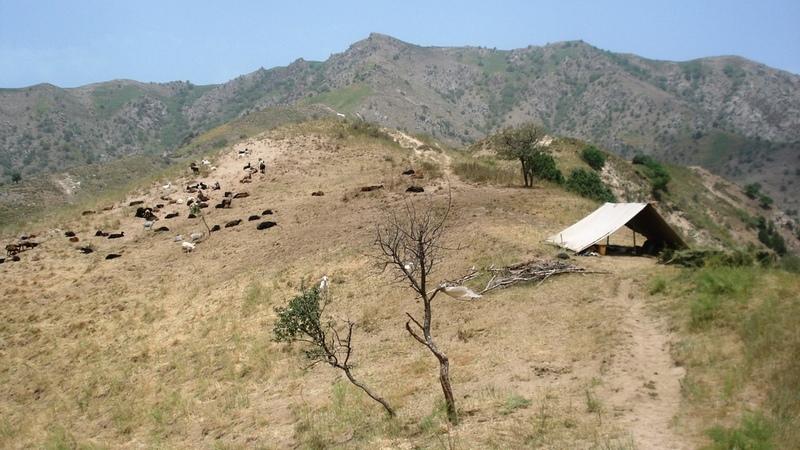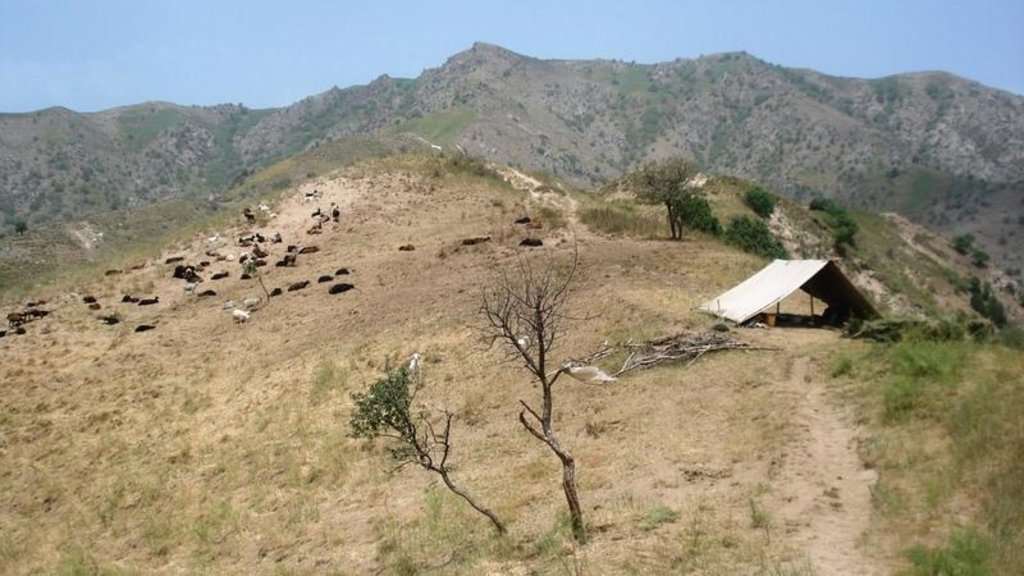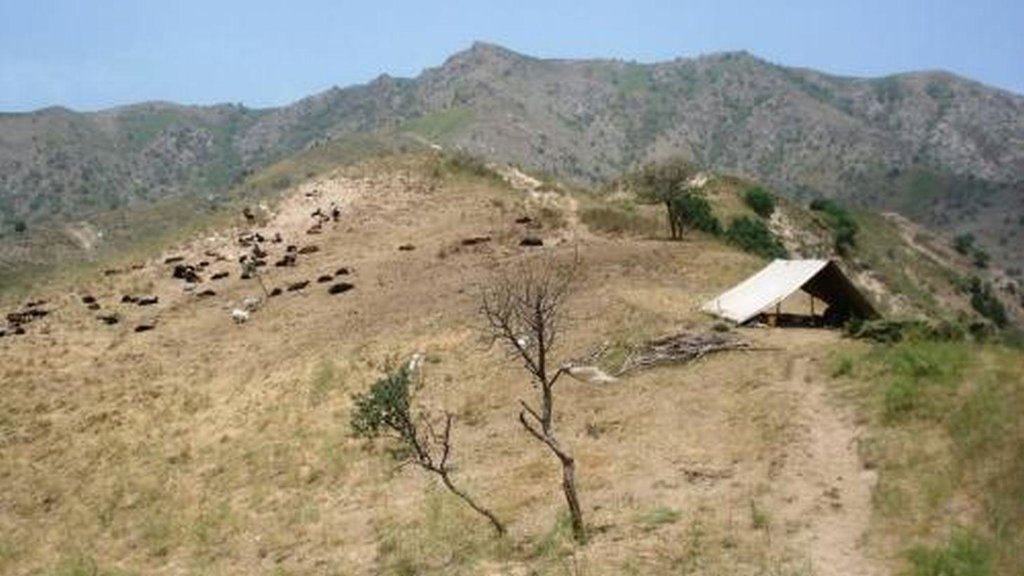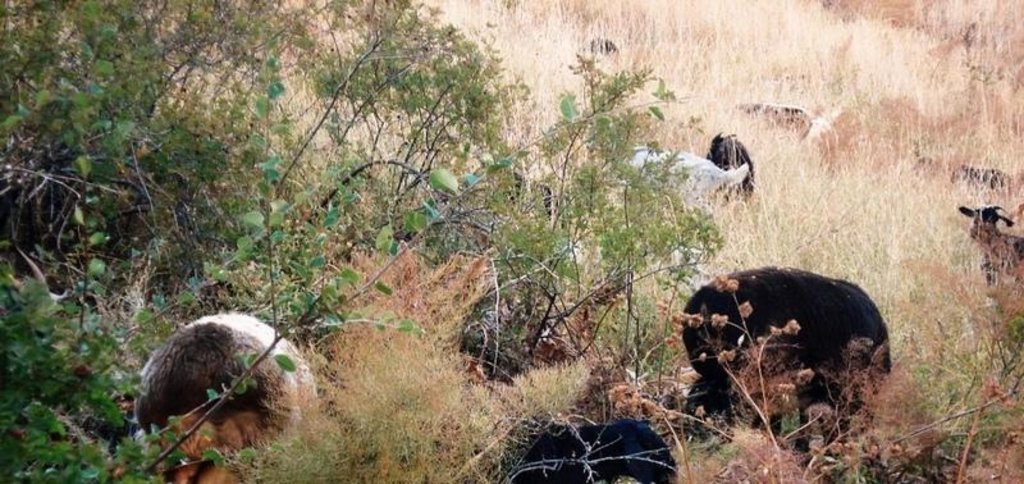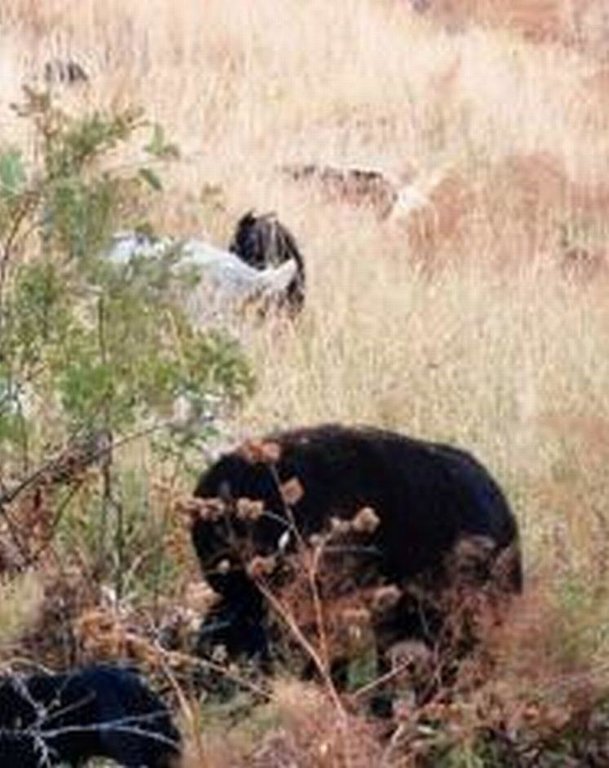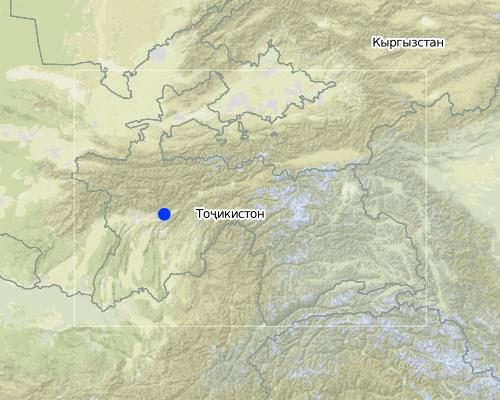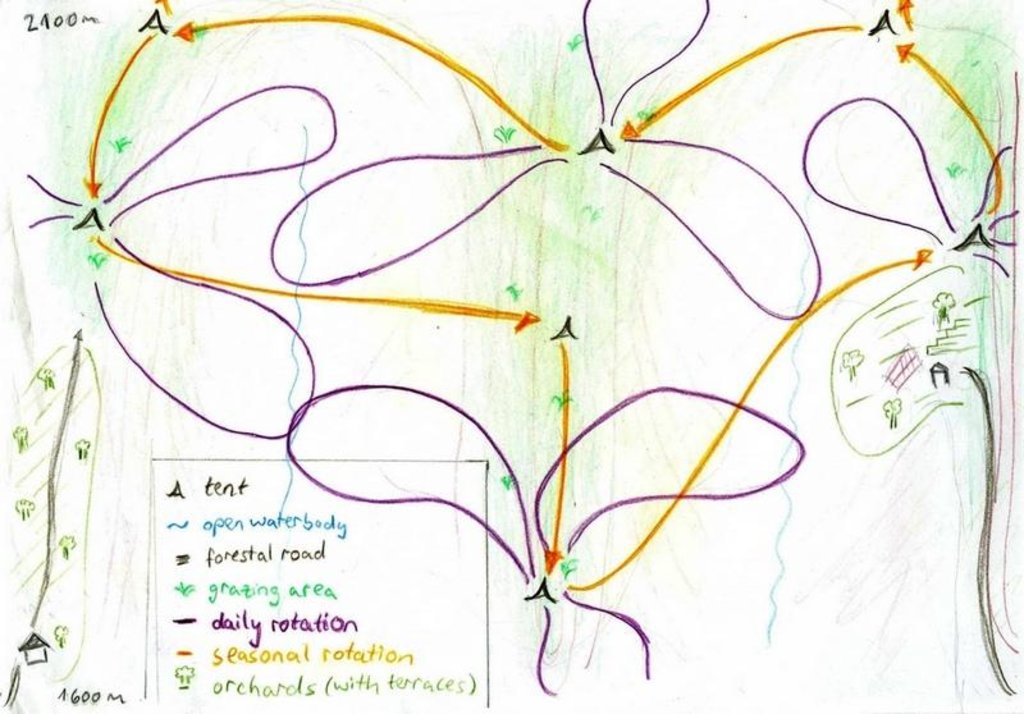Daily and seasonal rotation on grassland [ทาจิกิสถาน]
- ผู้สร้างสรรค์:
- การอัพเดท:
- ผู้รวบรวม: Christian Wirz
- ผู้เรียบเรียง: –
- ผู้ตรวจสอบ: David Streiff
Dajmardei Kaspi (professional herder)
technologies_1407 - ทาจิกิสถาน
ดูส่วนย่อย
ขยายทั้งหมด ย่อทั้งหมด1. ข้อมูลทั่วไป
1.2 รายละเอียดที่ติดต่อได้ของผู้รวบรวมและองค์กรที่เกี่ยวข้องในการประเมินและการจัดเตรียมทำเอกสารของเทคโนโลยี
ชื่อขององค์กรซึ่งอำนวยความสะดวกในการทำเอกสารหรือการประเมินเทคโนโลยี (ถ้าเกี่ยวข้อง)
CDE Centre for Development and Environment (CDE Centre for Development and Environment) - สวิตเซอร์แลนด์ชื่อขององค์กรซึ่งอำนวยความสะดวกในการทำเอกสารหรือการประเมินเทคโนโลยี (ถ้าเกี่ยวข้อง)
NCCR North-South (NCCR North-South) - คีร์กีซสถาน1.3 เงื่อนไขการใช้ข้อมูลที่ได้บันทึกผ่านทาง WOCAT
วันที่เก็บรวบรวมข้อมูล(ภาคสนาม) :
15/08/2008
ผู้รวบรวมและวิทยากรหลักยอมรับเงื่อนไขเกี่ยวกับการใช้ข้อมูลที่ถูกบันทึกผ่านทาง WOCAT:
ใช่
1.5 อ้างอิงไปที่แบบสอบถามเรื่องแนวทาง SLM
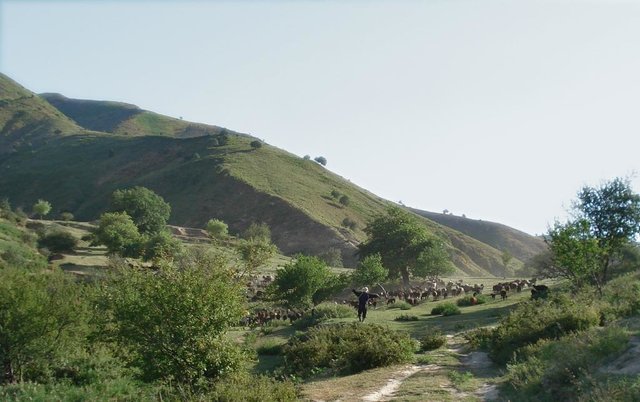
Seminomadic individual herding [ทาจิกิสถาน]
Pasture management by a single herder, assisted either by an employee or by his own grandchildren, in collaboration with the habitants of the nearby village Karsang.
- ผู้รวบรวม: Christian Wirz
2. การอธิบายลักษณะของเทคโนโลยี SLM
2.1 การอธิบายแบบสั้น ๆ ของเทคโนโลยี
คำจำกัดความของเทคโนโลยี:
Extensive grazing of sheep and goats by the means of a precise rotational scheme
2.2 การอธิบายแบบละเอียดของเทคโนโลยี
คำอธิบาย:
Half-year herding with 500 sheep, goats and cows (very few), with 7-8 different locations of the herder's tent. The herder visits each place twice to thrice per grazing season and stays in one place for one week to maximally one month (during the Ramadan period, due to limited forces). The area is grazed from the higher zone (around 2000m) to the lower zone (around 1600m) twice per season, in a sort of circle. Every day the herder starts in another direction from his tent and leads the animals to the pastures, once in the morning and once in the evening. He passes a stream once (autumn) to twice (summer) a day.
Purpose of the Technology: The grass should not get dusty and dirty, explaining why the herder daily changes the pastures, only revisiting the same places every two to three days.
Establishment / maintenance activities and inputs: After accompanying his father as a child and a kind of an apprenticeship (of one year) later on, M. is considered by the villagers as a good herder and they give him their animals for herding. But M. applies for land on the forest department only after working as a guardian and as a tractor driver for 20 years. For the herding profession observing the animals precisely is necessary, in order not to lose any of them. And the maintenance of the pastures is guaranteed by the strict rotational scheme.
Natural / human environment: The pasture-area is in a generally well-conserved state. Moderate to high values of fractional vegetation cover can be observed and only few signs of recent erosion processes (through water) are visible. The area is characterised by steep slopes where still signs of past tree-planting during the USSR period are visible by some trees, many little platforms made for tree-planting and a few terraced areas. Eventhough, many trees have been grazed and do not stand anymore. Besides steep areas there are small, quite flat areas (where the herder installs his tents), that used to be cultivated (wheat) till 1966. These areas generally have low cover-values and signs of rill-erosion, which the herder attributes to the past tilling activity. However, it might also be the trampling and sitting of the animals (staying near the herder's tent at noon-time and during the night) causing this erosion. Nutrient management is provided for by the dung of the animals which is not collected, contrarily to the pastures near the villages.
2.3 รูปภาพของเทคโนโลยี
2.5 ประเทศภูมิภาค หรือสถานที่ตั้งที่เทคโนโลยีได้นำไปใช้และได้รับการครอบคลุมโดยการประเมินนี้
ประเทศ:
ทาจิกิสถาน
ภูมิภาค/รัฐ/จังหวัด:
Region of Republican Subordination
ข้อมูลจำเพาะเพิ่มเติมของสถานที่ตั้ง :
Faizabad
Map
×2.6 วันที่การดำเนินการ
ถ้าไม่รู้ปีที่แน่นอน ให้ระบุวันที่โดยประมาณ:
- มากกว่า 50 ปี (แบบดั้งเดิม)
2.7 คำแนะนำของเทคโนโลยี
ให้ระบุว่าเทคโนโลยีถูกแนะนำเข้ามาอย่างไร:
- เป็นส่วนหนึ่งของระบบแบบดั้งเดิมที่ทำก้นอยู่ (> 50 ปี)
ความคิดเห็น (ประเภทของโครงการ เป็นต้น) :
There are traditional herding peoples like Kuagwates, Kaleks, Lakais, Duramanes, Kurtshaliks), not Tajiks. These often move around with their whole families.
3. การจัดประเภทของเทคโนโลยี SLM
3.2 ประเภทของการใช้ที่ดินในปัจจุบันที่ได้นำเทคโนโลยีไปใช้

ทุ่งหญ้าเลี้ยงสัตว์
ทุ่งหญ้าเลี้ยงสัตว์ที่ใช้พื้นที่กว้าง:
- กึ่งเร่ร่อน / อาจมีการทำทุ่งหญ้าเลี้ยงสัตว์ร่วมด้วย (Semi-nomadism/ pastoralism)
ชนิดพันธุ์สัตว์และผลิตภัณฑ์หลัก:
sheep* / goats* / cows
* if wildlife is major part of the grazing system
แสดงความคิดเห็น:
Major land use problems (compiler’s opinion): The trampling of the animals near the tent, the feeding on young trees and the daily passage of the herd of a limited number of streams (eutrophication).
Major land use problems (land users’ perception): No major land use problems due to good management. Only the first rain that cannot be absorbed by the dry soils is a problem.
Semi-nomadism / pastoralism: sheep* / goats* / cows
Future (final) land use (after implementation of SLM Technology): Grazing land: Ge: Extensive grazing land
ถ้าการใช้ที่ดินมีการเปลี่ยนแปลงเนื่องมาจากการนำเทคโนโลยีไปปฏิบัติใช้ ให้ระบุการใช้ที่ดินก่อนนำเทคโนโลยีไปปฏิบัติใช้:
Forests / woodlands: Fp: Plantations, afforestations
3.3 ข้อมูลเพิ่มเติมเกี่ยวกับการใช้ที่ดิน
การใช้น้ำของที่ดินที่มีการใช้เทคโนโลยีอยู่:
- จากน้ำฝน
จำนวนของฤดูเพาะปลูกต่อปี:
- 1
ระบุ:
Longest growing period in days: 270Longest growing period from month to month: Oct - Jun
ความหนาแน่นของปศุสัตว์ (ถ้าเกี่ยวข้อง):
< 1 LU/km2
3.4 กลุ่ม SLM ที่ตรงกับเทคโนโลยีนี้
- การจัดการปศุสัตว์และทุ่งหญ้าเลี้ยงสัตว์
3.5 กระจายตัวของเทคโนโลยี
แสดงความคิดเห็น:
Total area covered by the SLM Technology is 3 km2.
The half of the herded area is rented by another person from the village, who gives his animals to the herder. Apart from the interviewed herder there are varying numbers of other semi-nomadic herders with similar management practices, some of them from other regions.
3.6 มาตรการ SLM ที่ประกอบกันเป็นเทคโนโลยี

มาตรการอนุรักษ์ด้วยการจัดการ
- M1: การเปลี่ยนรูปแบบของการใช้ประโยชน์ที่ดิน
- M4: การเปลี่ยนแปลงช่วงเวลาให้เหมาะแก่การทำกิจกรรม
แสดงความคิดเห็น:
Main measures: management measures
3.7 รูปแบบหลักของการเสื่อมโทรมของที่ดินที่ได้รับการแก้ไขโดยเทคโนโลยี

การเสื่อมโทรมของดินทางด้านเคมี
- Cn (Fertility decline): ความอุดมสมบูรณ์และปริมาณอินทรียวัตถุในดินถูกทำให้ลดลงไป (ไม่ได้เกิดจากสาเหตุการกัดกร่อน)

การเสื่อมโทรมของดินทางด้านชีวภาพ
- Bs (Quality and species composition): องค์ประกอบหรือความหลากหลายทางคุณภาพและชนิดพันธุ์ลดลง
แสดงความคิดเห็น:
Secondary types of degradation addressed: Cn: fertility decline and reduced organic matter content, Bs: quality and species composition /diversity decline
Main causes of degradation: overgrazing (Causing Pc, Bc, Wt), droughts (Causing Pk, Pc, Ha), degradation of near-village pastures (The pressure on more distant areas increases)
Secondary causes of degradation: soil management (passed tilling with impact on Wt), floods (Intensive rains causing Wt), land tenure (Little interest in tree-planting if land can only be rented annually)
3.8 การป้องกัน การลดลง หรือการฟื้นฟูความเสื่อมโทรมของที่ดิน
ระบุเป้าหมายของเทคโนโลยีกับความเสื่อมโทรมของที่ดิน:
- ป้องกันความเสื่อมโทรมของที่ดิน
แสดงความคิดเห็น:
Main goals: prevention of land degradation
4. ข้อมูลจำเพาะด้านเทคนิค กิจกรรมการนำไปปฏิบัติใช้ ปัจจัยนำเข้า และค่าใช้จ่าย
4.1 แบบแปลนทางเทคนิคของเทคโนโลยี
4.2 ข้อมูลจำเพาะด้านเทคนิคและการอธิบายแบบแปลนทางเทคนิค
Daily and seasonal rotation.
Location: Above Karsang. Faizabad / Tajikistan
Date: 05.08.09
Technical knowledge required for field staff / advisors: low (Obeying to what the herder says)
Technical knowledge required for land users: moderate (It is necessary to know how to lead animals, more than in the case of the common pasture-area)
Main technical functions: control of dispersed runoff: retain / trap, increase of biomass (quantity)
Secondary technical functions: improvement of ground cover, control of fires, palatable fodder
Change of land use type: From afforestation and limited use as cropland to extensive grazing
Major change in timing of activities: Introduction of a strict rotational grazing scheme
4.3 ข้อมูลทั่วไปเกี่ยวกับการคำนวณปัจจัยนำเข้าและค่าใช้จ่าย
ระบุสกุลเงินที่ใช้คำนวณค่าใช้จ่าย:
- ดอลลาร์สหรัฐ
ระบุค่าเฉลี่ยของค่าจ้างในการจ้างแรงงานต่อวัน:
6.10
4.4 กิจกรรมเพื่อการจัดตั้ง
| กิจกรรม | ประเภทของมาตรการ | ช่วงเวลาดำเนินการ | |
|---|---|---|---|
| 1. | Buying a herd | ด้วยการจัดการ | constantly investing |
4.5 ค่าใช้จ่ายของปัจจัยนำเข้าที่จำเป็นสำหรับการจัดตั้ง
| ปัจจัยนำเข้า | หน่วย | ปริมาณ | ค่าใช้จ่ายต่อหน่วย | ค่าใช้จ่ายทั้งหมดต่อปัจจัยนำเข้า | %ของค่าใช้จ่ายที่ก่อให้เกิดขึ้นโดยผู้ใช้ที่ดิน | |
|---|---|---|---|---|---|---|
| อื่น ๆ | Buying a herd | animals | 50.0 | 87.7 | 4385.0 | 100.0 |
| ค่าใช้จ่ายทั้งหมดของการจัดตั้งเทคโนโลยี | 4385.0 | |||||
แสดงความคิดเห็น:
Duration of establishment phase: 12 month(s)
4.6 การบำรุงรักษาสภาพหรือกิจกรรมที่เกิดขึ้นเป็นประจำ
| กิจกรรม | ประเภทของมาตรการ | ช่วงระยะเวลา/ความถี่ | |
|---|---|---|---|
| 1. | Rent fee for land of forest department | ด้วยการจัดการ | once per year |
| 2. | Salary of an assistant herder (normally, but not in 2008) | ด้วยการจัดการ | at the end of the season |
| 3. | compensation for dead animals | ด้วยการจัดการ | at the end of the season |
| 4. | Animal medecine | ด้วยการจัดการ | if necessary |
| 5. | Salt | ด้วยการจัดการ | daily |
4.7 ค่าใช้จ่ายของปัจจัยนำเข้าและกิจกรรมที่เกิดขึ้นเป็นประจำที่ต้องการการบำรุงรักษา (ต่อปี)
| ปัจจัยนำเข้า | หน่วย | ปริมาณ | ค่าใช้จ่ายต่อหน่วย | ค่าใช้จ่ายทั้งหมดต่อปัจจัยนำเข้า | %ของค่าใช้จ่ายที่ก่อให้เกิดขึ้นโดยผู้ใช้ที่ดิน | |
|---|---|---|---|---|---|---|
| แรงงาน | Salary of an assistant herder | Days | 120.0 | 6.1 | 732.0 | 100.0 |
| อื่น ๆ | Rent fee for land of forest department | 300ha/d | 180.0 | 0.4888888 | 88.0 | 100.0 |
| อื่น ๆ | Compensation for dead animals | animals | 2.0 | 44.0 | 88.0 | 100.0 |
| อื่น ๆ | Animal medecine | per year | 1.0 | 88.0 | 88.0 | 100.0 |
| อื่น ๆ | Salt | kg | 1000.0 | 0.08 | 80.0 | 100.0 |
| ค่าใช้จ่ายทั้งหมดของการบำรุงรักษาสภาพเทคโนโลยี | 1076.0 | |||||
แสดงความคิดเห็น:
The costs are valid for a herd of 250 animals kept by the herder alone for six months and additional 250 animals kept during summer holidays with the help of additional workforce. The salary indicated was not valid for 2008 (the grandsons helped the herder), but for years when M. hires external workforce. For all costs, including 50 own animal, prices in 2008 are taken.
4.8 ปัจจัยสำคัญที่สุดที่มีผลกระทบต่อค่าใช้จ่าย
ปัจจัยสำคัญที่สุดที่มีผลกระทบต่อค่าใช้จ่ายต่างๆ:
Buying an own herd and looking for the animals are the most expensive factors, expecially if there are sick or dead animals.
5. สิ่งแวดล้อมทางธรรมชาติและของมนุษย์
5.1 ภูมิอากาศ
ฝนประจำปี
- < 250 ม.ม.
- 251-500 ม.ม.
- 501-750 ม.ม.
- 751-1,000 ม.ม.
- 1,001-1,500 ม.ม.
- 1,501-2,000 ม.ม.
- 2,001-3,000 ม.ม.
- 3,001-4,000 ม.ม.
- > 4,000 ม.ม.
ข้อมูลจำเพาะ/ความคิดเห็นเรื่องปริมาณน้ำฝน:
Mainly in spring and also in autumn, with a trend to decrease
เขตภูมิอากาศเกษตร
- กึ่งแห้งแล้ง
Thermal climate class: temperate
5.2 สภาพภูมิประเทศ
ค่าเฉลี่ยความลาดชัน:
- ราบเรียบ (0-2%)
- ลาดที่ไม่ชัน (3-5%)
- ปานกลาง (6-10%)
- เป็นลูกคลื่น (11-15%)
- เป็นเนิน (16-30%)
- ชัน (31-60%)
- ชันมาก (>60%)
ธรณีสัณฐาน:
- ที่ราบสูง/ที่ราบ
- สันเขา
- ไหล่เขา
- ไหล่เนินเขา
- ตีนเนิน
- หุบเขา
ระดับความสูง:
- 0-100 เมตร
- 101-500 เมตร
- 501-1,000 เมตร
- 1,001-1,500 เมตร
- 1,501-2,000 เมตร
- 2,001-2,500 เมตร
- 2,501-3,000 เมตร
- 3,001-4,000 เมตร
- > 4,000 เมตร
ความคิดเห็นและข้อมูลจำเพาะเพิ่มเติมเรื่องสภาพภูมิประเทศ:
Altitudinal zone: Pasture area around 1600 to 2000 m
Landforms ridges: Small, not so steep areas where the tent of the herder is installed
Landforms mountain slopes: The pasture area is generally very steep
Slopes on average steep (31-60%): The areas mostly frequented are steep
Slopes on average very steep (>60%): The areas dominating spatially are very steep
Slopes on average hilly (16-30%): Ridge areas
5.3 ดิน
ค่าเฉลี่ยความลึกของดิน:
- ตื้นมาก (0-20 ซ.ม.)
- ตื้น (21-50 ซ.ม.)
- ลึกปานกลาง (51-80 ซ.ม.)
- ลึก (81-120 ซ.ม.)
- ลึกมาก (>120 ซ.ม.)
เนื้อดิน (ดินชั้นบน):
- ปานกลาง (ดินร่วน ทรายแป้ง)
อินทรียวัตถุในดิน:
- ต่ำ (<1%)
(ถ้ามี) ให้แนบคำอธิบายเรื่องดินแบบเต็มหรือระบุข้อมูลที่มีอยู่ เช่น ชนิดของดิน ค่า pH ของดินหรือความเป็นกรดของดิน ความสามารถในการแลกเปลี่ยนประจุบวก ไนโตรเจน ความเค็ม เป็นต้น:
Soil depth on average shallow: Most grassy areas
Soil fertility is low: on the surface of 300 ha the summed up dung of 500 sheep and goats cannot compensate for the loss of topsoil by wind and water
Soil drainage / infiltration is good: Generally high infiltration capacity enhanced by high vegetation cover values
Soil water storage capacity medium (dominatig the area): Loamy soils and high cover values, but generally little trees and dried vegetation in August
Soil water storage capacity can also be good: Near the streams higher water retention, according to herder
5.4 ความเป็นประโยชน์และคุณภาพของน้ำ
น้ำไหลบ่าที่ผิวดิน:
ไม่ดีหรือไม่มีเลย
คุณภาพน้ำ (ที่ยังไม่ได้บำบัด):
เป็นน้ำใช้เพื่อการเกษตรเท่านั้น (การชลประทาน)
ความคิดเห็นและข้อมูลจำเพาะเพิ่มเติมเรื่องคุณภาพและปริมาณน้ำ:
Water quality (untreated): Locals drink the water, but are affected by diarrhoea
5.5 ความหลากหลายทางชีวภาพ
ความหลากหลายทางชนิดพันธุ์:
- สูง
ความคิดเห็นและข้อมูลจำเพาะเพิ่มเติมของความหลากหลายทางชีวภาพ:
Diversity higher than near the villages, but not comparable with biodiversity hot-spots
5.6 ลักษณะของผู้ใช้ที่ดินที่นำเทคโนโลยีไปปฏิบัติใช้
อยู่กับที่หรือเร่ร่อน:
- กึ่งเร่ร่อน
รายได้ที่มาจากนอกฟาร์ม:
- < 10% ของรายได้ทั้งหมด
ระดับของความมั่งคั่งโดยเปรียบเทียบ:
- รวย
เป็นรายบุคคล/ครัวเรือน:
- เป็นรายบุคคล/ครัวเรือน
เพศ:
- ชาย
ระบุลักษณะอื่นๆที่เกี่ยวข้องของผู้ใช้ที่ดิน:
Land users applying the Technology are mainly common / average land users
Difference in the involvement of women and men: Herding is considered as a male profession, inherited from father to son. In nomadic peoples the whole families are mobile and women are responsible for domestic work.
Population density: < 10 persons/km2
Annual population growth: 1% - 2%
100% of the land users are rich (100).
Off-farm income specification: The herder claims to nourish himself and his wife with the income from herding. But, once he willl not be able to work as a herder anymore, he might depend on off-farm income from his children (remittances)
5.7 พื้นที่เฉลี่ยของที่ดินที่เป็นเจ้าของหรือเช่าโดยผู้ใช้ที่ดินที่นำเทคโนโลยีไปปฏิบัติใช้
- < 0.5 เฮกตาร์
- 0.5-1 เฮกตาร์
- 1-2 เฮกตาร์
- 2-5 เฮกตาร์
- 5-15 เฮกตาร์
- 15-50 เฮกตาร์
- 50-100 เฮกตาร์
- 100-500 เฮกตาร์
- 500-1,000 เฮกตาร์
- 1,000-10,000 เฮกตาร์
- >10,000 เฮกตาร์
พิจารณาว่าเป็นขนาดเล็ก กลาง หรือขนาดใหญ่ (ซึ่งอ้างอิงถึงบริบทระดับท้องถิ่น):
- ขนาดเล็ก
แสดงความคิดเห็น:
3 households can afford to pay the services of the professional herder (clearly a minority of village population)
5.8 กรรมสิทธิ์ในที่ดิน สิทธิในการใช้ที่ดินและสิทธิในการใช้น้ำ
กรรมสิทธิ์ในที่ดิน:
- รัฐ
สิทธิในการใช้ที่ดิน:
- เช่า
สิทธิในการใช้น้ำ:
- เกี่ยวกับชุมชน (ถูกจัดระเบียบ)
5.9 การเข้าถึงบริการและโครงสร้างพื้นฐาน
สุขภาพ:
- จน
- ปานกลาง
- ดี
การศึกษา:
- จน
- ปานกลาง
- ดี
ความช่วยเหลือทางด้านเทคนิค:
- จน
- ปานกลาง
- ดี
การจ้างงาน (เช่น ภายนอกฟาร์ม):
- จน
- ปานกลาง
- ดี
ตลาด:
- จน
- ปานกลาง
- ดี
พลังงาน:
- จน
- ปานกลาง
- ดี
ถนนและการขนส่ง:
- จน
- ปานกลาง
- ดี
น้ำดื่มและการสุขาภิบาล:
- จน
- ปานกลาง
- ดี
บริการด้านการเงิน:
- จน
- ปานกลาง
- ดี
6. ผลกระทบและสรุปคำบอกกล่าว
6.1 ผลกระทบในพื้นที่ดำเนินการ (On-site) จากการใช้เทคโนโลยี
ผลกระทบทางด้านเศรษฐกิจและสังคม
การผลิต
การผลิตพืชที่ใช้เลี้ยงปศุสัตว์
แสดงความคิดเห็น/ระบุ:
Higher vegetation cover and biomass values than for village-pastures
คุณภาพพืชที่ใช้เลี้ยงปศุสัตว์
แสดงความคิดเห็น/ระบุ:
Much less impalatable species' frequency
การผลิตสัตว์
แสดงความคิดเห็น/ระบุ:
The animals get much fatter and are sold for around 50% higher price than animals from common pastures
การผลิตไม้
แสดงความคิดเห็น/ระบุ:
The herder says that tree density has decreased, due to livestock but also to chopping. Additionally chopping of living trees is generally forbidden (since the 1960s, when the forest department was created as a new land use type), not making possible the
พื้นที่สำหรับการผลิต
แสดงความคิดเห็น/ระบุ:
The use of the land for fruit production is not possible with animals grazing, but this was also the case before, as to the herder's opinion
ความเป็นประโยชน์และคุณภาพของน้ำ
คุณภาพน้ำสำหรับการชลประทาน
แสดงความคิดเห็น/ระบุ:
Due to reduced stocking rates in comparison with village-pastures (and the soviet times), better water quality
ผลกระทบด้านสังคมวัฒนธรรมอื่น ๆ
ความมั่นคงด้านอาหาร / พึ่งตนเองได้
สถานการณ์ด้านสุขภาพ
โอกาสทางด้านสันทนาการ
Livelihoods and human well-being
ผลกระทบด้านนิเวศวิทยา
วัฐจักรน้ำหรือน้ำบ่า
น้ำไหลบ่าที่ผิวดิน
แสดงความคิดเห็น/ระบุ:
Better control of runoff, but steeper land
การระบายน้ำส่วนเกิน
ดิน
สิ่งปกคลุมดิน
จำนวนก่อน SLM:
40%
หลังจาก SLM:
80%
แสดงความคิดเห็น/ระบุ:
Higher cover than on village-pastures
ความหลากหลายทางชีวภาพของพืชและสัตว์
ความหลากหลายทางชีวภาพของพืช
จำนวนก่อน SLM:
36 species
หลังจาก SLM:
47 species
แสดงความคิดเห็น/ระบุ:
More plant systematical diversity
ลดความเสี่ยงของภัยพิบัติ
ความเสี่ยงจากไฟ
แสดงความคิดเห็น/ระบุ:
According to forest department the area above Karsang, due to ist trees, is more prone to fires than other areas
6.3 การเผชิญและความตอบสนองของเทคโนโลยีต่อการเปลี่ยนแปลงสภาพภูมิอากาศที่ค่อยเป็นค่อยไป และสภาพรุนแรงของภูมิอากาศ / ภัยพิบัติ (ที่รับรู้ได้โดยผู้ใช้ที่ดิน)
สภาพรุนแรงของภูมิอากาศ (ภัยพิบัติ)
ภัยพิบัติจากสภาพภูมิอากาศ
| เทคโนโลยีมีวิธีการรับมืออย่างไร | |
|---|---|
| ภัยจากฝนแล้ง | ไม่ค่อยดี |
ผลลัพธ์ตามมาที่เกี่ยวข้องกับภูมิอากาศอื่น ๆ
ผลลัพธ์ตามมาที่เกี่ยวข้องกับภูมิอากาศอื่น ๆ
| เทคโนโลยีมีวิธีการรับมืออย่างไร | |
|---|---|
| ช่วงการปลูกพืชที่ลดลงมา | ดี |
แสดงความคิดเห็น:
A possible adaption to dryer conditions would be smaller herds.
6.4 การวิเคราะห์ค่าใช้จ่ายและผลประโยชน์ที่ได้รับ
ผลประโยชน์ที่ได้รับเปรียบเทียบกับค่าใช้จ่ายในการจัดตั้งเป็นอย่างไร (จากมุมมองของผู้ใช้ที่ดิน)
ผลตอบแทนระยะสั้น:
เป็นกลางหรือสมดุล
ผลตอบแทนระยะยาว:
ด้านบวกอย่างมาก
ผลประโยชน์ที่ได้รับเปรียบเทียบกับค่าใช้จ่ายในการบำรุงรักษาหรือต้นทุนที่เกิดขึ้นซ้ำอีก เป็นอย่างไร (จากมุมมองของผู้ใช้ที่ดิน)
ผลตอบแทนระยะสั้น:
ด้านบวกเล็กน้อย
ผลตอบแทนระยะยาว:
ด้านบวก
แสดงความคิดเห็น:
4 Years ago a herd of 400 animals had to be sold due to disease. Since then M was able to rebuild a herd of 500 animals. On a short term investing into animals is expensive but pays quickly. The maintenance costs are finally decisive, but quite constant.
6.5 การปรับตัวของเทคโนโลยี
- ครั้งเดียวหรือเป็นการทดลอง
ถ้ามีข้อมูลให้บอกปริมาณด้วย (จำนวนของครัวเรือนหรือครอบคลุมพื้นที่):
1 Household
จากทั้งหมดที่ได้รับเทคโนโลยีเข้ามามีจำนวนเท่าใดที่ทำแบบทันที โดยไม่ได้รับการจูงใจด้านวัสดุหรือการเงินใด ๆ:
- 0-10%
แสดงความคิดเห็น:
100% of land user families have adopted the Technology with external material support
1 land user families have adopted the Technology with external material support
Comments on acceptance with external material support: The herder gets paid by the villagers for taking care of their animals
There is no trend towards spontaneous adoption of the Technology
Comments on adoption trend: According to the herder, young people do not (want to) bear the very physical work.
6.7 จุดแข็ง / ข้อได้เปรียบ / โอกาสของเทคโนโลยี
| จุดแข็ง / ข้อได้เปรียบ / โอกาสในทัศนคติของผู้ใช้ที่ดิน |
|---|
|
Grazing stabilises the soils and is thus a prevention against gully erosion in areas with low cover (former cropland). Animals have the same effect as the terraces built years ago. How can they be sustained / enhanced? Grazing activity should continue, once M. is too old for working. |
| The animals provide for soil fertility by their dung, instead of the fertilisers used in Soviet times. This positively influences the share of palatable plants and cover in general and, by this, soil moisture. |
| The area on the forest department is a good alternative to the much too small pasture-area near the village |
| จุดแข็ง / ข้อได้เปรียบ / โอกาสในทัศนคติของผู้รวบรวมหรือวิทยากรหลัก |
|---|
|
Form of land use making it possible to take some pressure from the common pastures without great damages. How can they be sustained / enhanced? It needs to be assured that also poorer families, who depend even more on livestock breeding than richer ones, can give their animals to M. or other professional herders. This could be realised by engaging herder assistants from poor families |
|
The rotational scheme is much more elaborated than in the case of the villages' pastures, which can be explained by more land available How can they be sustained / enhanced? Land users like M. should be addressed by forest administration to elaborate legal forms of herding with little damages on natural resources on this land. This will probably require land reforms. |
6.8 จุดอ่อน / ข้อเสียเปรียบ / ความเสี่ยงของเทคโนโลยีและวิธีการแก้ไข
| จุดอ่อน / ข้อเสียเปรียบ / ความเสี่ยงในทัศนคติของผู้ใช้ที่ดิน | มีวิธีการแก้ไขได้อย่างไร |
|---|---|
| Tree planting is not possible as long as the area is used for grazing. | By giving people land for longer periods (than one year) and with more freedoms in its use, people would gain interest in diversifying use: They would split up "their" land into haymaking, orchard and pasture areas. |
| จุดอ่อน / ข้อเสียเปรียบ / ความเสี่ยงในทัศนคติของผู้รวบรวมหรือวิทยากรหลัก | มีวิธีการแก้ไขได้อย่างไร |
|---|---|
| The main problem of this form of grazing is that it doesn't allow the regrowth of trees. | Changing the areas use for grazing, respectively haymaking, every few years. |
| Cover is markedly reduced around the places where tents are installed. | By changing the camping place (but: limited flat areas!) or not keeping the animals in the same place at noon time and during night time, these areas might recover. |
ลิงก์และโมดูล
ขยายทั้งหมด ย่อทั้งหมดลิงก์

Seminomadic individual herding [ทาจิกิสถาน]
Pasture management by a single herder, assisted either by an employee or by his own grandchildren, in collaboration with the habitants of the nearby village Karsang.
- ผู้รวบรวม: Christian Wirz
โมดูล
ไม่มีโมดูล


